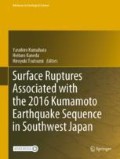Abstract
The ~7-km-long N20°E-trending southernmost section of the 2016 surface rupture extended from Shirahata to Oike and is characterized by a relatively simple and straight trace. This section cuts across alluvial plains and fluvial terrace surfaces and closely coincided with the previously mapped active fault trace. The section seemed to rupture the northernmost part of the NNE-trending Hinagu fault, or a transition zone between the Hinagu fault and the NE-trending Futagawa fault. Right-lateral offset was commonly observed along this section of the surface rupture, with offsets ranging from a few to 65 cm. In contrast, vertical displacement was largely negligible.
Note
The supplementary material of this book contains geographical information system (GIS) and spreadsheet files of the surface ruptures associated with the mainshock of the 2016 Kumamoto earthquake sequence
Access this chapter
Tax calculation will be finalised at checkout
Purchases are for personal use only
References
Ikeda Y, Chida N, Nakata T, Kaneda H, Tajikara M, Takazawa S (2001) 1:25,000 Active fault map in urban area, Kumamoto. Geospatial Information Authority of Japan
Lin A, Chen P, Satsukawa T, Sado K, Takahashi N, Hirata S (2017) Millennium recurrence interval of morphogenic earthquakes on the seismogenic fault zone that triggered the 2016 Mw 7.1 Kumamoto Earthquake, Southwest Japan. Bull Seismol Soc Am 107(6):2687–2702
Shirahama Y, Miyashita Y, Kametaka M, Suzuki Y, Miyairi Y, Yokoyama Y (2020) Detailed paleoseismic history of the Hinagu fault zone revealed by the high‐density radiocarbon dating and trenching survey across a surface rupture of the 2016 Kumamoto earthquake, Kyushu, Japan. Island arc 30. https://doi.org/10.1111/iar.12376
Shimokawa K, Kinugasa Y (1999) Paleoseismicity and activity study of the Hinagu fault system. Interim report on active fault and paleoearthquake researches in the 1998 fiscal year, Geological Survey of Japan, no.EQ/99/3, 253–262
Acknowledgements
This study was supported by the JSPS grants 18H03601.
Author information
Authors and Affiliations
Corresponding author
Editor information
Editors and Affiliations
1 Electronic supplementary material
Below is the link to the electronic supplementary material.
Rights and permissions
Copyright information
© 2022 The Author(s), under exclusive license to Springer Nature Singapore Pte Ltd.
About this chapter
Cite this chapter
Kumahara, Y., Ishiyama, T., Matta, N., Kagohara, K., Hirouchi, D., Ishiguro, S. (2022). Surface Ruptures of the Shirahata–Oike Section. In: Kumahara, Y., Kaneda, H., Tsutsumi, H. (eds) Surface Ruptures Associated with the 2016 Kumamoto Earthquake Sequence in Southwest Japan. Advances in Geological Science. Springer, Singapore. https://doi.org/10.1007/978-981-19-1150-7_7
Download citation
DOI: https://doi.org/10.1007/978-981-19-1150-7_7
Published:
Publisher Name: Springer, Singapore
Print ISBN: 978-981-19-1149-1
Online ISBN: 978-981-19-1150-7
eBook Packages: Earth and Environmental ScienceEarth and Environmental Science (R0)

